HI6006 Competitive Strategy Essay: Key Strategy Development Tools
VerifiedAdded on 2022/10/11
|6
|2085
|15
Essay
AI Summary
This essay provides a comprehensive analysis of competitive strategy, focusing on three key models: PESTEL, Porter's Five Forces, and the Ansoff Matrix. The PESTEL analysis examines the political, economic, social, technological, environmental, and legal factors influencing businesses, using examples like China and the US. Porter's Five Forces model assesses the competitive landscape by evaluating the threat of new entrants, bargaining power of suppliers and buyers, threat of substitutes, and rivalry within the industry, with examples from Apple, Nike, airlines, and coffee shops. The Ansoff Matrix explores market penetration, market development, product development, and diversification strategies, illustrated by examples from Vodafone, Adidas, Nike, Puma, Apple, and Samsung. The essay emphasizes the importance of these strategies for maintaining a competitive edge and achieving maximum profit margins in the business market.
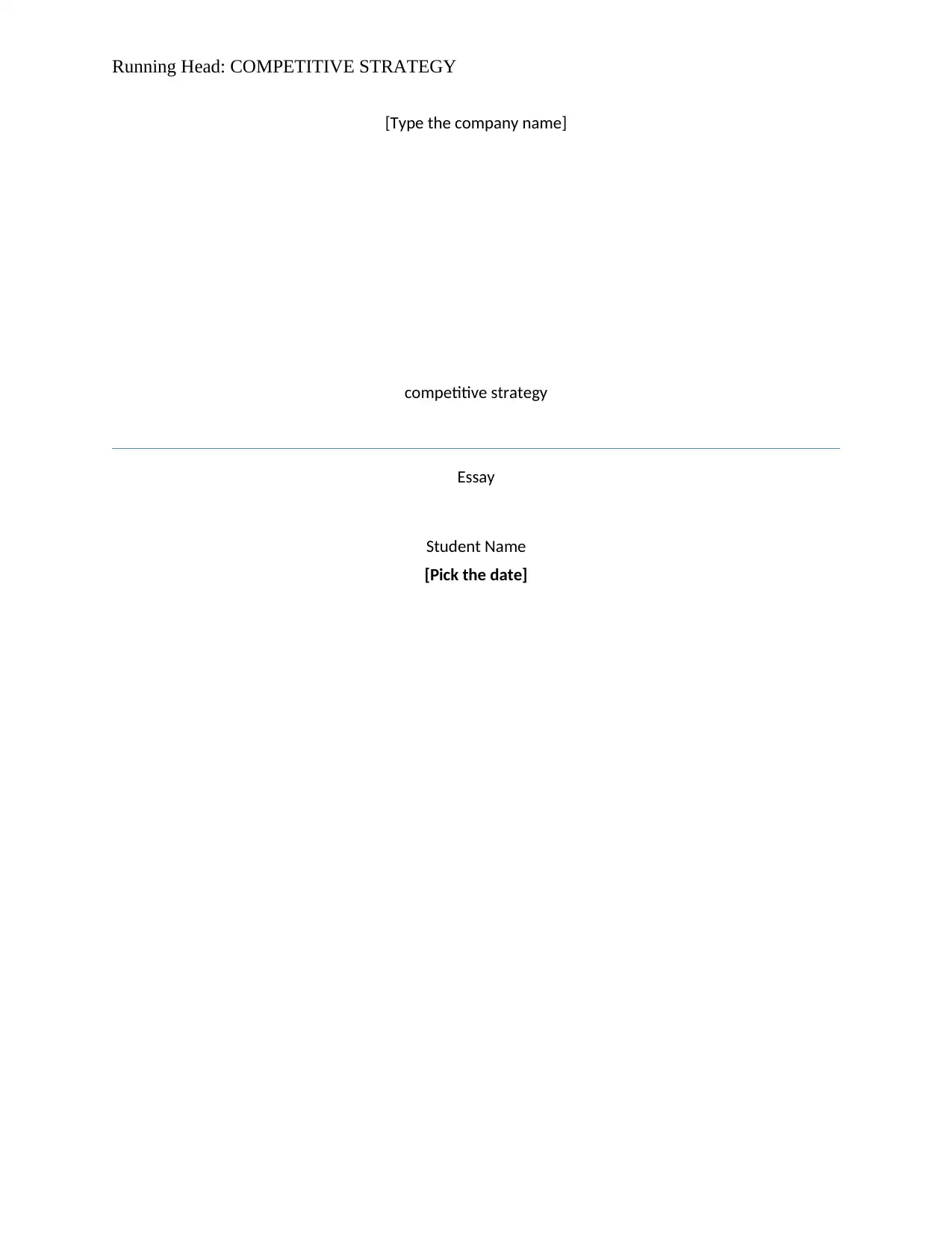
Running Head: COMPETITIVE STRATEGY
[Type the company name]
competitive strategy
Essay
Student Name
[Pick the date]
[Type the company name]
competitive strategy
Essay
Student Name
[Pick the date]
Paraphrase This Document
Need a fresh take? Get an instant paraphrase of this document with our AI Paraphraser
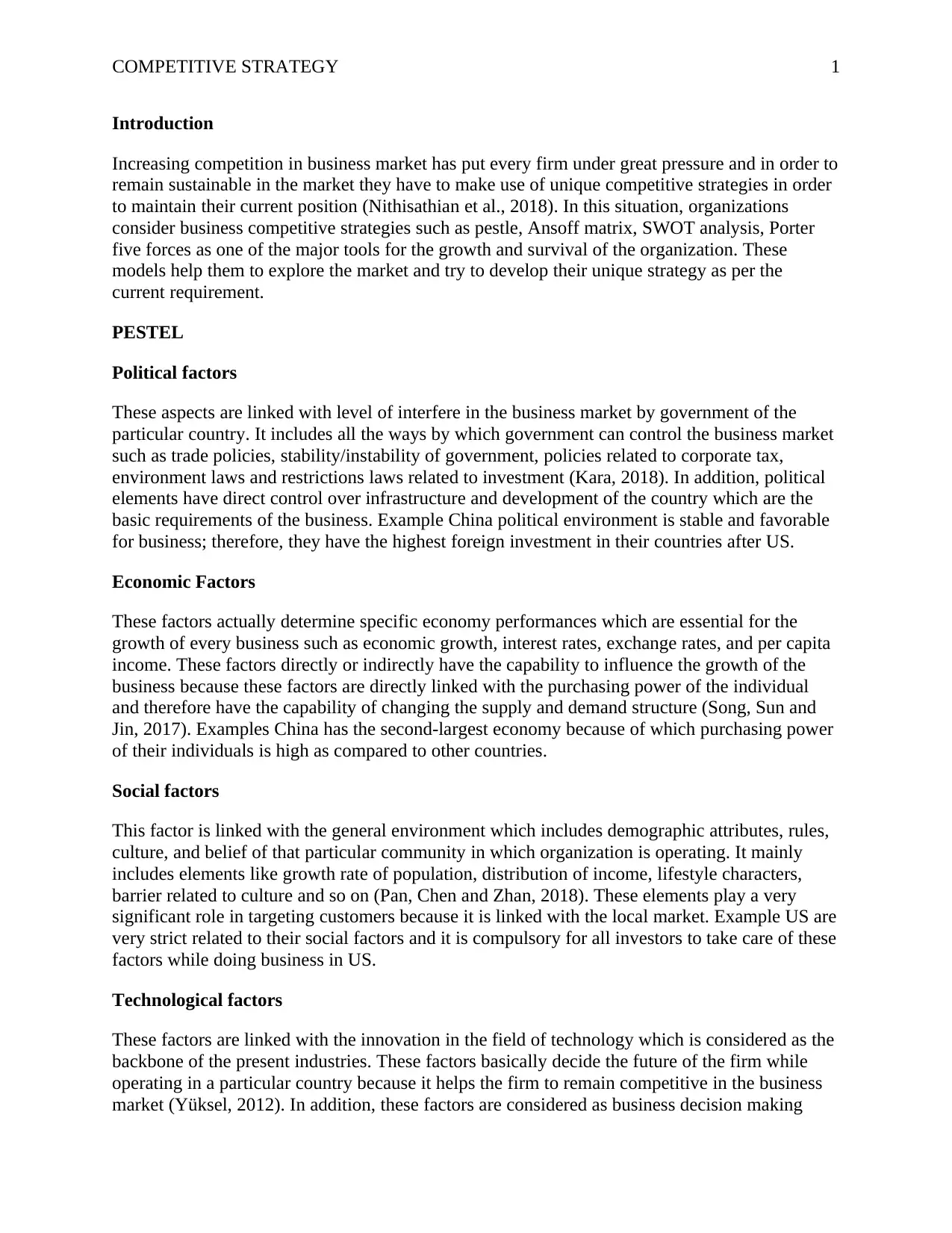
COMPETITIVE STRATEGY 1
Introduction
Increasing competition in business market has put every firm under great pressure and in order to
remain sustainable in the market they have to make use of unique competitive strategies in order
to maintain their current position (Nithisathian et al., 2018). In this situation, organizations
consider business competitive strategies such as pestle, Ansoff matrix, SWOT analysis, Porter
five forces as one of the major tools for the growth and survival of the organization. These
models help them to explore the market and try to develop their unique strategy as per the
current requirement.
PESTEL
Political factors
These aspects are linked with level of interfere in the business market by government of the
particular country. It includes all the ways by which government can control the business market
such as trade policies, stability/instability of government, policies related to corporate tax,
environment laws and restrictions laws related to investment (Kara, 2018). In addition, political
elements have direct control over infrastructure and development of the country which are the
basic requirements of the business. Example China political environment is stable and favorable
for business; therefore, they have the highest foreign investment in their countries after US.
Economic Factors
These factors actually determine specific economy performances which are essential for the
growth of every business such as economic growth, interest rates, exchange rates, and per capita
income. These factors directly or indirectly have the capability to influence the growth of the
business because these factors are directly linked with the purchasing power of the individual
and therefore have the capability of changing the supply and demand structure (Song, Sun and
Jin, 2017). Examples China has the second-largest economy because of which purchasing power
of their individuals is high as compared to other countries.
Social factors
This factor is linked with the general environment which includes demographic attributes, rules,
culture, and belief of that particular community in which organization is operating. It mainly
includes elements like growth rate of population, distribution of income, lifestyle characters,
barrier related to culture and so on (Pan, Chen and Zhan, 2018). These elements play a very
significant role in targeting customers because it is linked with the local market. Example US are
very strict related to their social factors and it is compulsory for all investors to take care of these
factors while doing business in US.
Technological factors
These factors are linked with the innovation in the field of technology which is considered as the
backbone of the present industries. These factors basically decide the future of the firm while
operating in a particular country because it helps the firm to remain competitive in the business
market (Yüksel, 2012). In addition, these factors are considered as business decision making
Introduction
Increasing competition in business market has put every firm under great pressure and in order to
remain sustainable in the market they have to make use of unique competitive strategies in order
to maintain their current position (Nithisathian et al., 2018). In this situation, organizations
consider business competitive strategies such as pestle, Ansoff matrix, SWOT analysis, Porter
five forces as one of the major tools for the growth and survival of the organization. These
models help them to explore the market and try to develop their unique strategy as per the
current requirement.
PESTEL
Political factors
These aspects are linked with level of interfere in the business market by government of the
particular country. It includes all the ways by which government can control the business market
such as trade policies, stability/instability of government, policies related to corporate tax,
environment laws and restrictions laws related to investment (Kara, 2018). In addition, political
elements have direct control over infrastructure and development of the country which are the
basic requirements of the business. Example China political environment is stable and favorable
for business; therefore, they have the highest foreign investment in their countries after US.
Economic Factors
These factors actually determine specific economy performances which are essential for the
growth of every business such as economic growth, interest rates, exchange rates, and per capita
income. These factors directly or indirectly have the capability to influence the growth of the
business because these factors are directly linked with the purchasing power of the individual
and therefore have the capability of changing the supply and demand structure (Song, Sun and
Jin, 2017). Examples China has the second-largest economy because of which purchasing power
of their individuals is high as compared to other countries.
Social factors
This factor is linked with the general environment which includes demographic attributes, rules,
culture, and belief of that particular community in which organization is operating. It mainly
includes elements like growth rate of population, distribution of income, lifestyle characters,
barrier related to culture and so on (Pan, Chen and Zhan, 2018). These elements play a very
significant role in targeting customers because it is linked with the local market. Example US are
very strict related to their social factors and it is compulsory for all investors to take care of these
factors while doing business in US.
Technological factors
These factors are linked with the innovation in the field of technology which is considered as the
backbone of the present industries. These factors basically decide the future of the firm while
operating in a particular country because it helps the firm to remain competitive in the business
market (Yüksel, 2012). In addition, these factors are considered as business decision making
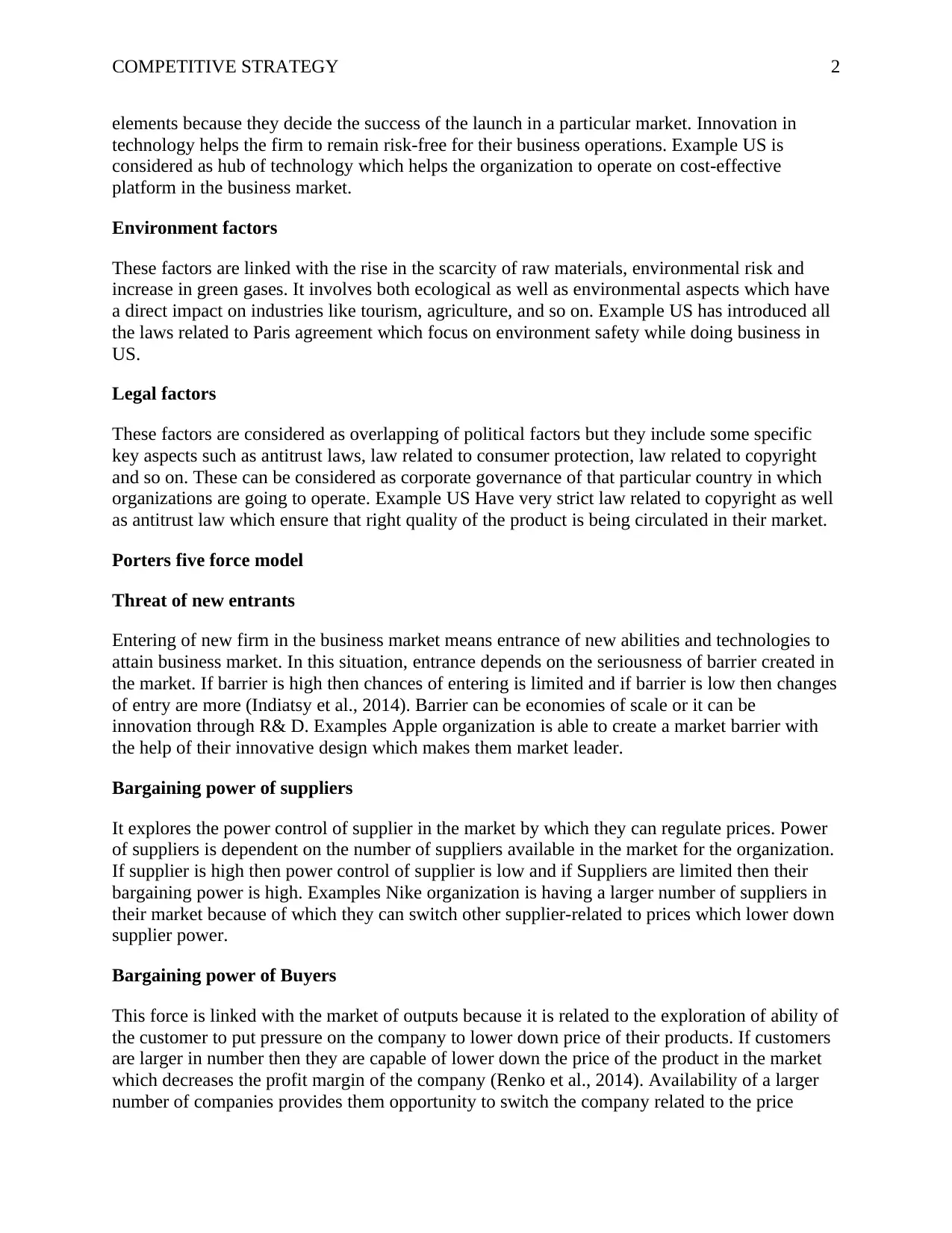
COMPETITIVE STRATEGY 2
elements because they decide the success of the launch in a particular market. Innovation in
technology helps the firm to remain risk-free for their business operations. Example US is
considered as hub of technology which helps the organization to operate on cost-effective
platform in the business market.
Environment factors
These factors are linked with the rise in the scarcity of raw materials, environmental risk and
increase in green gases. It involves both ecological as well as environmental aspects which have
a direct impact on industries like tourism, agriculture, and so on. Example US has introduced all
the laws related to Paris agreement which focus on environment safety while doing business in
US.
Legal factors
These factors are considered as overlapping of political factors but they include some specific
key aspects such as antitrust laws, law related to consumer protection, law related to copyright
and so on. These can be considered as corporate governance of that particular country in which
organizations are going to operate. Example US Have very strict law related to copyright as well
as antitrust law which ensure that right quality of the product is being circulated in their market.
Porters five force model
Threat of new entrants
Entering of new firm in the business market means entrance of new abilities and technologies to
attain business market. In this situation, entrance depends on the seriousness of barrier created in
the market. If barrier is high then chances of entering is limited and if barrier is low then changes
of entry are more (Indiatsy et al., 2014). Barrier can be economies of scale or it can be
innovation through R& D. Examples Apple organization is able to create a market barrier with
the help of their innovative design which makes them market leader.
Bargaining power of suppliers
It explores the power control of supplier in the market by which they can regulate prices. Power
of suppliers is dependent on the number of suppliers available in the market for the organization.
If supplier is high then power control of supplier is low and if Suppliers are limited then their
bargaining power is high. Examples Nike organization is having a larger number of suppliers in
their market because of which they can switch other supplier-related to prices which lower down
supplier power.
Bargaining power of Buyers
This force is linked with the market of outputs because it is related to the exploration of ability of
the customer to put pressure on the company to lower down price of their products. If customers
are larger in number then they are capable of lower down the price of the product in the market
which decreases the profit margin of the company (Renko et al., 2014). Availability of a larger
number of companies provides them opportunity to switch the company related to the price
elements because they decide the success of the launch in a particular market. Innovation in
technology helps the firm to remain risk-free for their business operations. Example US is
considered as hub of technology which helps the organization to operate on cost-effective
platform in the business market.
Environment factors
These factors are linked with the rise in the scarcity of raw materials, environmental risk and
increase in green gases. It involves both ecological as well as environmental aspects which have
a direct impact on industries like tourism, agriculture, and so on. Example US has introduced all
the laws related to Paris agreement which focus on environment safety while doing business in
US.
Legal factors
These factors are considered as overlapping of political factors but they include some specific
key aspects such as antitrust laws, law related to consumer protection, law related to copyright
and so on. These can be considered as corporate governance of that particular country in which
organizations are going to operate. Example US Have very strict law related to copyright as well
as antitrust law which ensure that right quality of the product is being circulated in their market.
Porters five force model
Threat of new entrants
Entering of new firm in the business market means entrance of new abilities and technologies to
attain business market. In this situation, entrance depends on the seriousness of barrier created in
the market. If barrier is high then chances of entering is limited and if barrier is low then changes
of entry are more (Indiatsy et al., 2014). Barrier can be economies of scale or it can be
innovation through R& D. Examples Apple organization is able to create a market barrier with
the help of their innovative design which makes them market leader.
Bargaining power of suppliers
It explores the power control of supplier in the market by which they can regulate prices. Power
of suppliers is dependent on the number of suppliers available in the market for the organization.
If supplier is high then power control of supplier is low and if Suppliers are limited then their
bargaining power is high. Examples Nike organization is having a larger number of suppliers in
their market because of which they can switch other supplier-related to prices which lower down
supplier power.
Bargaining power of Buyers
This force is linked with the market of outputs because it is related to the exploration of ability of
the customer to put pressure on the company to lower down price of their products. If customers
are larger in number then they are capable of lower down the price of the product in the market
which decreases the profit margin of the company (Renko et al., 2014). Availability of a larger
number of companies provides them opportunity to switch the company related to the price
You're viewing a preview
Unlock full access by subscribing today!
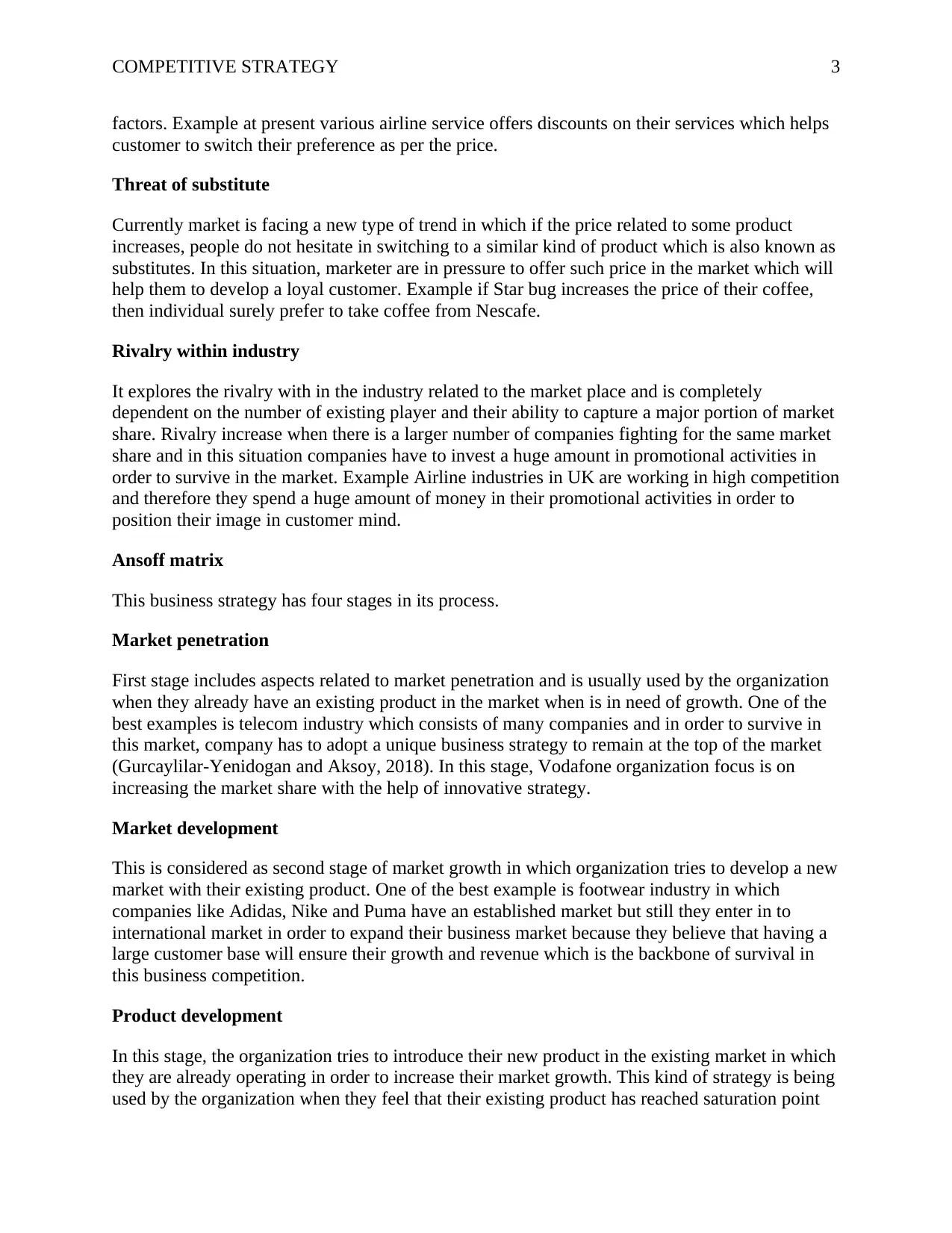
COMPETITIVE STRATEGY 3
factors. Example at present various airline service offers discounts on their services which helps
customer to switch their preference as per the price.
Threat of substitute
Currently market is facing a new type of trend in which if the price related to some product
increases, people do not hesitate in switching to a similar kind of product which is also known as
substitutes. In this situation, marketer are in pressure to offer such price in the market which will
help them to develop a loyal customer. Example if Star bug increases the price of their coffee,
then individual surely prefer to take coffee from Nescafe.
Rivalry within industry
It explores the rivalry with in the industry related to the market place and is completely
dependent on the number of existing player and their ability to capture a major portion of market
share. Rivalry increase when there is a larger number of companies fighting for the same market
share and in this situation companies have to invest a huge amount in promotional activities in
order to survive in the market. Example Airline industries in UK are working in high competition
and therefore they spend a huge amount of money in their promotional activities in order to
position their image in customer mind.
Ansoff matrix
This business strategy has four stages in its process.
Market penetration
First stage includes aspects related to market penetration and is usually used by the organization
when they already have an existing product in the market when is in need of growth. One of the
best examples is telecom industry which consists of many companies and in order to survive in
this market, company has to adopt a unique business strategy to remain at the top of the market
(Gurcaylilar-Yenidogan and Aksoy, 2018). In this stage, Vodafone organization focus is on
increasing the market share with the help of innovative strategy.
Market development
This is considered as second stage of market growth in which organization tries to develop a new
market with their existing product. One of the best example is footwear industry in which
companies like Adidas, Nike and Puma have an established market but still they enter in to
international market in order to expand their business market because they believe that having a
large customer base will ensure their growth and revenue which is the backbone of survival in
this business competition.
Product development
In this stage, the organization tries to introduce their new product in the existing market in which
they are already operating in order to increase their market growth. This kind of strategy is being
used by the organization when they feel that their existing product has reached saturation point
factors. Example at present various airline service offers discounts on their services which helps
customer to switch their preference as per the price.
Threat of substitute
Currently market is facing a new type of trend in which if the price related to some product
increases, people do not hesitate in switching to a similar kind of product which is also known as
substitutes. In this situation, marketer are in pressure to offer such price in the market which will
help them to develop a loyal customer. Example if Star bug increases the price of their coffee,
then individual surely prefer to take coffee from Nescafe.
Rivalry within industry
It explores the rivalry with in the industry related to the market place and is completely
dependent on the number of existing player and their ability to capture a major portion of market
share. Rivalry increase when there is a larger number of companies fighting for the same market
share and in this situation companies have to invest a huge amount in promotional activities in
order to survive in the market. Example Airline industries in UK are working in high competition
and therefore they spend a huge amount of money in their promotional activities in order to
position their image in customer mind.
Ansoff matrix
This business strategy has four stages in its process.
Market penetration
First stage includes aspects related to market penetration and is usually used by the organization
when they already have an existing product in the market when is in need of growth. One of the
best examples is telecom industry which consists of many companies and in order to survive in
this market, company has to adopt a unique business strategy to remain at the top of the market
(Gurcaylilar-Yenidogan and Aksoy, 2018). In this stage, Vodafone organization focus is on
increasing the market share with the help of innovative strategy.
Market development
This is considered as second stage of market growth in which organization tries to develop a new
market with their existing product. One of the best example is footwear industry in which
companies like Adidas, Nike and Puma have an established market but still they enter in to
international market in order to expand their business market because they believe that having a
large customer base will ensure their growth and revenue which is the backbone of survival in
this business competition.
Product development
In this stage, the organization tries to introduce their new product in the existing market in which
they are already operating in order to increase their market growth. This kind of strategy is being
used by the organization when they feel that their existing product has reached saturation point
Paraphrase This Document
Need a fresh take? Get an instant paraphrase of this document with our AI Paraphraser
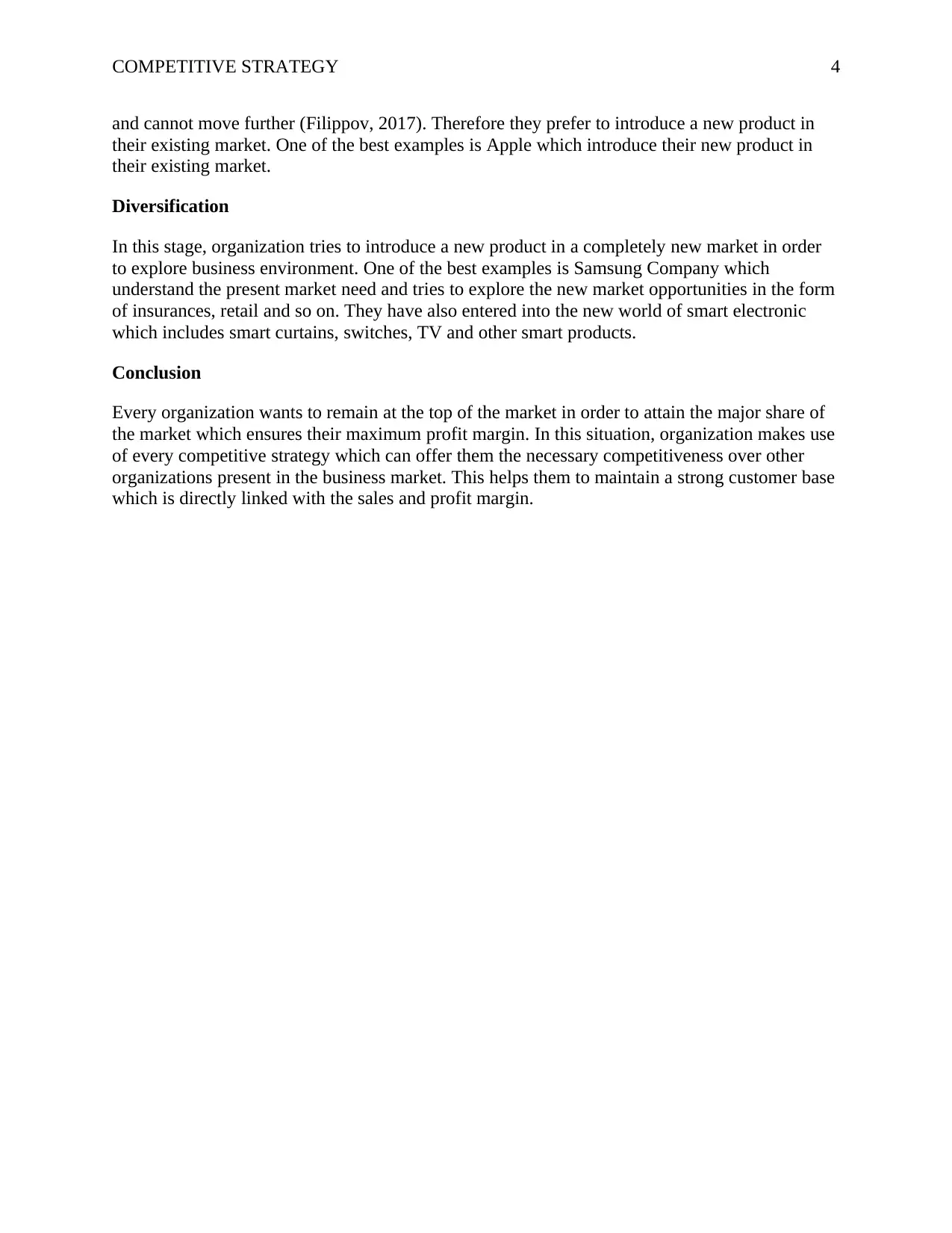
COMPETITIVE STRATEGY 4
and cannot move further (Filippov, 2017). Therefore they prefer to introduce a new product in
their existing market. One of the best examples is Apple which introduce their new product in
their existing market.
Diversification
In this stage, organization tries to introduce a new product in a completely new market in order
to explore business environment. One of the best examples is Samsung Company which
understand the present market need and tries to explore the new market opportunities in the form
of insurances, retail and so on. They have also entered into the new world of smart electronic
which includes smart curtains, switches, TV and other smart products.
Conclusion
Every organization wants to remain at the top of the market in order to attain the major share of
the market which ensures their maximum profit margin. In this situation, organization makes use
of every competitive strategy which can offer them the necessary competitiveness over other
organizations present in the business market. This helps them to maintain a strong customer base
which is directly linked with the sales and profit margin.
and cannot move further (Filippov, 2017). Therefore they prefer to introduce a new product in
their existing market. One of the best examples is Apple which introduce their new product in
their existing market.
Diversification
In this stage, organization tries to introduce a new product in a completely new market in order
to explore business environment. One of the best examples is Samsung Company which
understand the present market need and tries to explore the new market opportunities in the form
of insurances, retail and so on. They have also entered into the new world of smart electronic
which includes smart curtains, switches, TV and other smart products.
Conclusion
Every organization wants to remain at the top of the market in order to attain the major share of
the market which ensures their maximum profit margin. In this situation, organization makes use
of every competitive strategy which can offer them the necessary competitiveness over other
organizations present in the business market. This helps them to maintain a strong customer base
which is directly linked with the sales and profit margin.
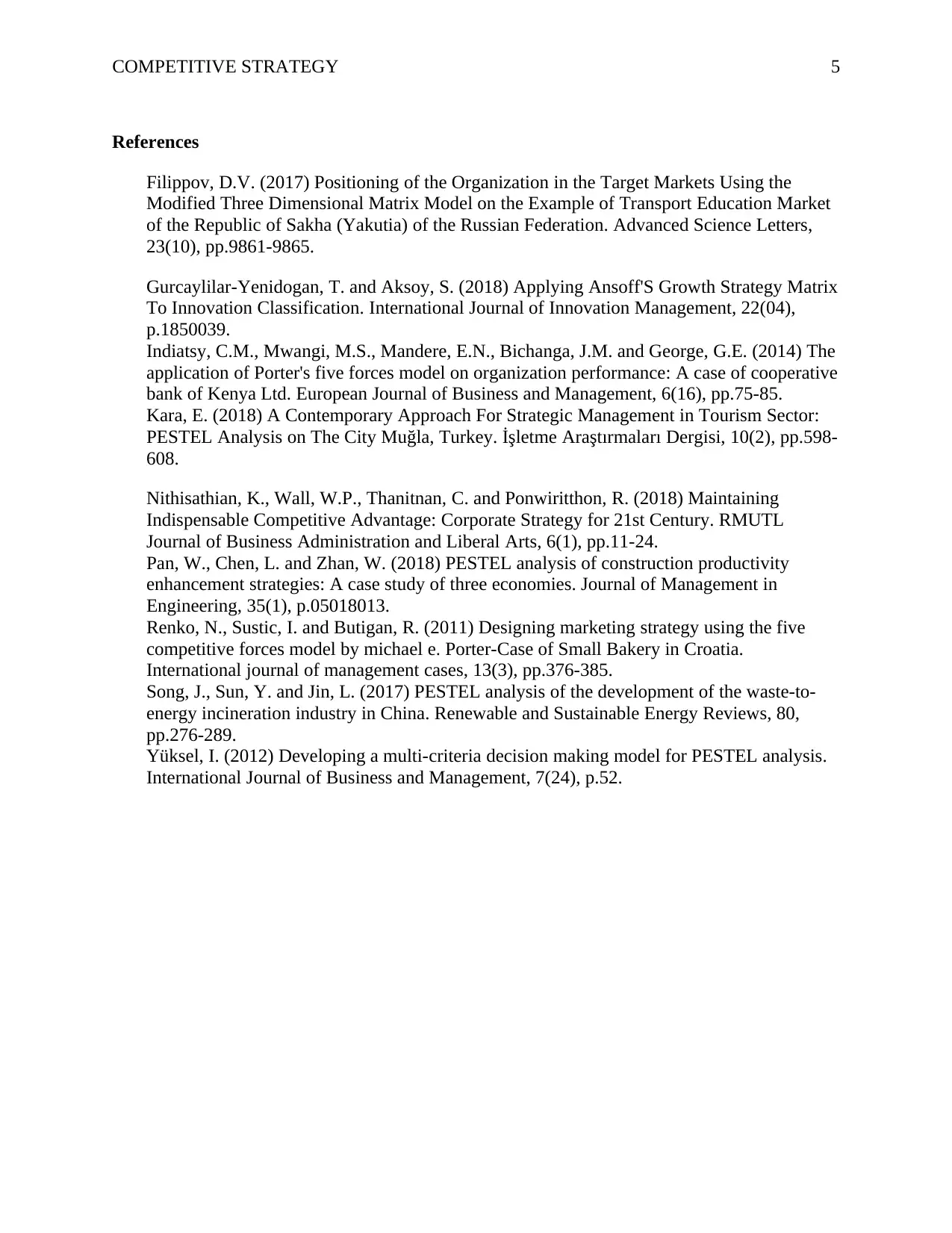
COMPETITIVE STRATEGY 5
References
Filippov, D.V. (2017) Positioning of the Organization in the Target Markets Using the
Modified Three Dimensional Matrix Model on the Example of Transport Education Market
of the Republic of Sakha (Yakutia) of the Russian Federation. Advanced Science Letters,
23(10), pp.9861-9865.
Gurcaylilar-Yenidogan, T. and Aksoy, S. (2018) Applying Ansoff'S Growth Strategy Matrix
To Innovation Classification. International Journal of Innovation Management, 22(04),
p.1850039.
Indiatsy, C.M., Mwangi, M.S., Mandere, E.N., Bichanga, J.M. and George, G.E. (2014) The
application of Porter's five forces model on organization performance: A case of cooperative
bank of Kenya Ltd. European Journal of Business and Management, 6(16), pp.75-85.
Kara, E. (2018) A Contemporary Approach For Strategic Management in Tourism Sector:
PESTEL Analysis on The City Muğla, Turkey. İşletme Araştırmaları Dergisi, 10(2), pp.598-
608.
Nithisathian, K., Wall, W.P., Thanitnan, C. and Ponwiritthon, R. (2018) Maintaining
Indispensable Competitive Advantage: Corporate Strategy for 21st Century. RMUTL
Journal of Business Administration and Liberal Arts, 6(1), pp.11-24.
Pan, W., Chen, L. and Zhan, W. (2018) PESTEL analysis of construction productivity
enhancement strategies: A case study of three economies. Journal of Management in
Engineering, 35(1), p.05018013.
Renko, N., Sustic, I. and Butigan, R. (2011) Designing marketing strategy using the five
competitive forces model by michael e. Porter-Case of Small Bakery in Croatia.
International journal of management cases, 13(3), pp.376-385.
Song, J., Sun, Y. and Jin, L. (2017) PESTEL analysis of the development of the waste-to-
energy incineration industry in China. Renewable and Sustainable Energy Reviews, 80,
pp.276-289.
Yüksel, I. (2012) Developing a multi-criteria decision making model for PESTEL analysis.
International Journal of Business and Management, 7(24), p.52.
References
Filippov, D.V. (2017) Positioning of the Organization in the Target Markets Using the
Modified Three Dimensional Matrix Model on the Example of Transport Education Market
of the Republic of Sakha (Yakutia) of the Russian Federation. Advanced Science Letters,
23(10), pp.9861-9865.
Gurcaylilar-Yenidogan, T. and Aksoy, S. (2018) Applying Ansoff'S Growth Strategy Matrix
To Innovation Classification. International Journal of Innovation Management, 22(04),
p.1850039.
Indiatsy, C.M., Mwangi, M.S., Mandere, E.N., Bichanga, J.M. and George, G.E. (2014) The
application of Porter's five forces model on organization performance: A case of cooperative
bank of Kenya Ltd. European Journal of Business and Management, 6(16), pp.75-85.
Kara, E. (2018) A Contemporary Approach For Strategic Management in Tourism Sector:
PESTEL Analysis on The City Muğla, Turkey. İşletme Araştırmaları Dergisi, 10(2), pp.598-
608.
Nithisathian, K., Wall, W.P., Thanitnan, C. and Ponwiritthon, R. (2018) Maintaining
Indispensable Competitive Advantage: Corporate Strategy for 21st Century. RMUTL
Journal of Business Administration and Liberal Arts, 6(1), pp.11-24.
Pan, W., Chen, L. and Zhan, W. (2018) PESTEL analysis of construction productivity
enhancement strategies: A case study of three economies. Journal of Management in
Engineering, 35(1), p.05018013.
Renko, N., Sustic, I. and Butigan, R. (2011) Designing marketing strategy using the five
competitive forces model by michael e. Porter-Case of Small Bakery in Croatia.
International journal of management cases, 13(3), pp.376-385.
Song, J., Sun, Y. and Jin, L. (2017) PESTEL analysis of the development of the waste-to-
energy incineration industry in China. Renewable and Sustainable Energy Reviews, 80,
pp.276-289.
Yüksel, I. (2012) Developing a multi-criteria decision making model for PESTEL analysis.
International Journal of Business and Management, 7(24), p.52.
You're viewing a preview
Unlock full access by subscribing today!
1 out of 6
Related Documents
Your All-in-One AI-Powered Toolkit for Academic Success.
+13062052269
info@desklib.com
Available 24*7 on WhatsApp / Email
![[object Object]](/_next/static/media/star-bottom.7253800d.svg)
Unlock your academic potential
© 2024 | Zucol Services PVT LTD | All rights reserved.





